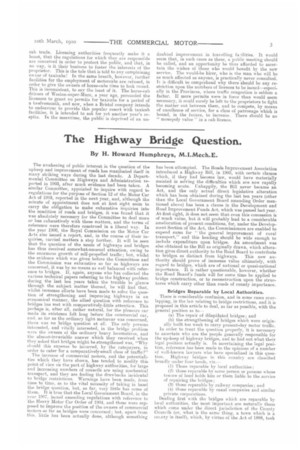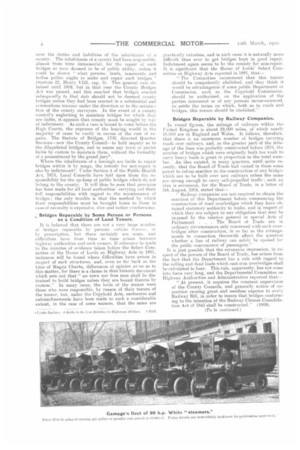The Highway Bridge Question.
Page 3

Page 4

If you've noticed an error in this article please click here to report it so we can fix it.
By H. Howard Humphreys, M.I.Mech.E.
The awakening of public interest in the question of the upkeep and improvement of roads has manifested itself in many striking ways during the last decade. A Departmental Committee on Highways and Administration reported in 1903, after much evidence had been taken. A similar Committee, appointed to inquire with regard to regulations for the purpose of Section 12 of the Motor Car Act of 1903, reported in the next year, and, although the minute of appointment does not at first sight seem to carry the obligation to make exhaustive inquiries into the condition of roads and bridges, it was found that it was absolutely necessary for the Committee to deal more or lees exhaustively with these matters, and the terms of reference were therefore construed in a liberal way. In the year 1906, the Royal Commission on the Motor Car Acts also issued a report, and, in the course of their inquiries, carried matters a step further. It will be seen that the question of the needs of highways and bridges has thus received somewhat-unusual attention, owing to the enormous growth of self-propelled traffic ; but, whilst the evidence which was given before the Committees and the Commission was exhaustive so far as highways are concerned, it was by no means as well balanced with reference to bridges, if, again, anyone who has collected the various technical papers referring to the highway problem during the last ten years takes the trouble to glance through the subject matter thereof, he will find that, whilst immense efforts have been made to solve the question of strengthening and improving highways in an economical manner, the allied question with reference to bridges has met with comparatively-little attention. This perhaps is, after all, rather natural, for the pleasure car made its existence felt long before the commercial car, and, so far as the ordinary light motorcar was concerned, there was no bridge question at all. The only persons interested, and vitally interested, in the bridge problem were the owners of the ordinary heavy locomotives, and the almost-invariable answer which they received when they asked that bridges might be strengthened was, "Why should this expense be incurred, by the ratepayers, in order to cater for a comparatively-small class of traffic?"
The increase of commercial motors, and the potentialities which they have shown, has tended to modify this point of view on the part of highway authorities, for large and increasing numbers of councils are using mechanical transport, and they are finding the drawbacks incidental to bridge restrictions. Warnings have been made, from time to time, as to the vital necessity of taking in hand the bridge question, but, so far, very little has come of them. It is true that the Local Government Board, in the year 1907, issued amending regulations with reference to the Heavy Motor Car Order of 1904, and those were supposed to improve the position of the owners of commercial motors so far as bridges were concerned; but, apart from this, little has been actually done, although something has been attempted. The Roads Improvement Association introduced a Highway Bill, in 1905, with certain clauses which, if they had become law, would have materially assisted in solving the difficulties which are now rapidly becoming acute, Unhappily, the Bill never became an Act, and the only actual direct legislative alteration which has been obtained during the last ten years (other than the Local Government Board amending Order mentioned above) has been a clause in the Development and Road Improvement Funds Act, which was passed last year. At first sight, it does not seem that even this concession is of much value, but it will probably lead to a considerable amelioration of present conditions, for, under the Development Section of the Act, the Commissioners are enabled to expend sums for " the general improvement of rural transport," and this heading should be wide enough to include expenditure upon bridges. An amendment was also obtained to the Bill as originally drawn, which alteration gives direct authority to the Road Board to contribute to bridges as distinct from highways. This new authority should prove of immense value ultimately, with regard to bridges, which are of national or quasi-national importance. It is rather questionable, however, whether the Road Board's funds will for some time be applied to bridge construction, or to reconstruction upon the structures which carry other than roads of county importance.
Bridges Reparable by Local Authorities.
There is considerable confusion, and in some cases overlapping, in the law relating to bridge restrictions, and it is proposed in this article to deal, as far as possible, with the general position as to—
(a) The repair of dilapidated bridges; and
(b) the strengthening of bridges which were originally built too weak to carry present-day motor traffic. lii order to treat the question properly, it is necessary to ascertain who are the people generally responsible for the up-keep of highway bridges, and to find out what their legal position actually is. In ascertaining the legal position, reference has been made to the opinions of a number of well-known lawyers who have specialized in this question. Highway bridges in this country are classified broadly under four heads, viz.-
(I) Those reparable by local authorities ; (2) those reparable by some person or persons whose tenure of land holds him or them liable to the service of repairing the bridges; (3) those reparable by railway companies; and (4) those reparable by canal companies and similar private corporations. Dealing first with the bridges which are reparable by local authorities, the. most important are naturally those which come under the direct jurisdiction of the County Councils (or, what is the same thing. a town which is a county in itself), which, by virtue of the Act of 1888, took
over the duties and liabilities of the inhabitants Of a county. The inhabitants of a county had been responsible, almost from time immemorial, for the repair of sueli bridges as were deemed to be of public utility, unless it could be shown " what persons, lands, tenements and bodies politic ought to make and repair such bridges " (Statute 22, Henry V111, cap. 5). This general rule obtained until 1803, but in that year the County Bridges Act was passed, and this enacted that bridges erected subsequently to that date should not be deemed county bridges unless they had been erected in a substantial and ccmm(xlious manner under the direction or to the satisfaction of the county surveyors. In the event of a county council's neglecting to maintain bridges for which they are liable, it appears that remedy must be sought by way of indictment. As such a case is bound to come before the High Courts, the expenses of the hearing would in the majority of cases be vastly in excess of the cost of repairs. The Statute of Bridges, 1702, directed Quarter Sessions—now the County Council—to hold inquiry as to the dilapidated bridges, and to assess any town or parish liable by custom to maintain them, without the formality of a presentment by the grand jury*.
Where the inhabitants of a borough are liable to repair bridges within it by usage, the remedy for non-repair is also by indictmentf. Under Section 4 of the Public Health Act, 1875, Local Councils have laid upon them the responsibility for the up-keep of public bridges which do not belong to the county. It will thus be seen that provision has been made for all local authorities' carrying out their full responsibilities with regard to the maintenance of bridges; the only trouble is that the method by which their responsibilities must be brought home to them in sass of necessity is expensive, slow and rather cumbersome.
' Bridges Reparable by Some Person or Persons as a Condition of Land Tenure.
It is believed that there are not a very large number of brid!ses reparable by persons rations fin eras or by prescription, but there certainly are sonic. and difficulties have from time to time arisen between highway authorities and sitch owners. If reference be made to the minutes of evidence taken before the Select Committee of the House of Lords on Highway Acts in 1881, instances will be found where difficulties have arisen in respect of such structures, and, even as far back as the time of Magna Charts, differences of opinion arse RS to this matter, for there is a clause in that historic document which sets out that " no town nor free man shall be distrained to build bridges unless they are bound thereto by custom." In many cases, the lords of the manor were those who were responsible, by reason of their tenure of the manor, but, under the Copyhold Acts, enclosures sad enfranchisements have been made to such a considerable extent, in the case of some manors, that the same are
practically valueless, and in such cases it is naturally more difficult than ever to get bridge-s kept in goad repair. Indictment again seems to be the remedy fur non-repair. It is significant that the House of Lords' Select Committee on Highway Acts reported in 1881, that " The Committee recommend that this tenure should be compulsorily abolished, and they think it would be advantageous if some public Department or Commission, such as the Copyhold Commission, should be authorized, on the application of the Parties interested or of any persons inconvenienced, to settle the terms on which, both as to roads and bridges, this tenure should he abolished."
Bridges Reparable by Railway Companies.
In round figures, the mileage of railways within the United Kingdom is about 23,000 miles, of which nearly 10,000 are in England and Wales. It follows, therefore, that there is an enormous number of bridges carryins, roads over railways, and, as the greater part of the mile age of the lines was probably constructed before 1870, the number of bridges which were originally built too weak to carry heavy loads is great in proportion to the total num ber. An idea existed, in many quarters, until quite re cently, that the Board, of Trade had vested in them some power to refuse sanction to the construction of any bridges which are to be built over new railways unless the same are strong enough to carry self-propelled traffic : such an idea is erroneous, for the Board of Trade, in a letter of 5th August, 1904, stated that ' Railway companies are not required to obtain the sanction of this Department before ernnmencing the construction of road overbridges which they have ob tained statutory authority to make, and in respect of which they are subject to any obligation that may be
imposed by the relative general or special Acts of Parliament . . The Board of Trade are in ordinary circumstances only concerned with such overbridges after construction, in so far as the arrangements in connection therewith affect the question whether a line of railway can safely be opened for the public convenience of passengers."
It is just passible that the erroneous impression, in respect of the powers of the Board of Trade, has arisen from the fact that the Department has a rule with regard to the rolling and dead loads which cast-iron overhridges shall be calculated to bear. This rule, apparently, has not conic into force very long, and the Departmental Committee on Highway Authorities and Administration reported that " At present, it requires the constant supervision
of the County Councils, and generally notice of opposition causing great and needless expense to every
Railway Bill, in order to insure that bridges conforming to the intention of the Railway Clauses Consolidation Art of 1845 shall be constructed." (190.3).




















